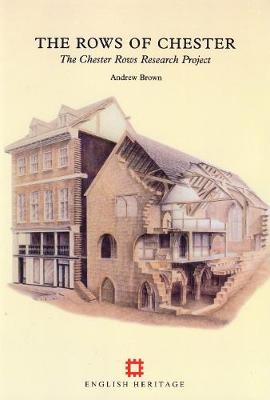English Heritage Archaeological Report
1 primary work
Book 16
Almost ten years of historical and archaeological research on the Rows of Chester, the most extensive surviving example in Europe of a medieval two-tier complex of shops, are detailed in this thorough and authoritative report.
The Rows of Chester form a unique system of walkways through the frontages of buildings on the city's four main streets. They pass above the street-level shops, giving access to a second tier of shops at Row (first floor) level.
Established in 1984, the Chester Rows Research Project aimed to survey all the Rows buildings using an interdisciplinary approach, in which an appreciation of the architectural and social influences that gave rise to the two-tier system were combined with archaeological investigation and historical research. The ultimate aim was to understand the origins of the Rows and the reasons for their survival.
There is no evidence for an imposed planning scheme at any stage. The Rows system developed in the Middle Ages, especially during a prosperous period fostered by the Edwardian campaigns in North Wales. A century or more of subsequent economic depression helped to preserve the Rows system from change. Despite commercial recovery in the seventeenth century, two thirds of the Rows survived despite extensive redevelopment of the Row buildings.
Copious fascinating illustrations include archival prints of the Rows in the eighteenth and nineteenth centuries; early photographs of them before the Victorian rebuilding of the Vernacular revival; colour reproductions of reconstruction drawings, and attractive Victorian and Edwardian water colours.
The Rows of Chester form a unique system of walkways through the frontages of buildings on the city's four main streets. They pass above the street-level shops, giving access to a second tier of shops at Row (first floor) level.
Established in 1984, the Chester Rows Research Project aimed to survey all the Rows buildings using an interdisciplinary approach, in which an appreciation of the architectural and social influences that gave rise to the two-tier system were combined with archaeological investigation and historical research. The ultimate aim was to understand the origins of the Rows and the reasons for their survival.
There is no evidence for an imposed planning scheme at any stage. The Rows system developed in the Middle Ages, especially during a prosperous period fostered by the Edwardian campaigns in North Wales. A century or more of subsequent economic depression helped to preserve the Rows system from change. Despite commercial recovery in the seventeenth century, two thirds of the Rows survived despite extensive redevelopment of the Row buildings.
Copious fascinating illustrations include archival prints of the Rows in the eighteenth and nineteenth centuries; early photographs of them before the Victorian rebuilding of the Vernacular revival; colour reproductions of reconstruction drawings, and attractive Victorian and Edwardian water colours.
